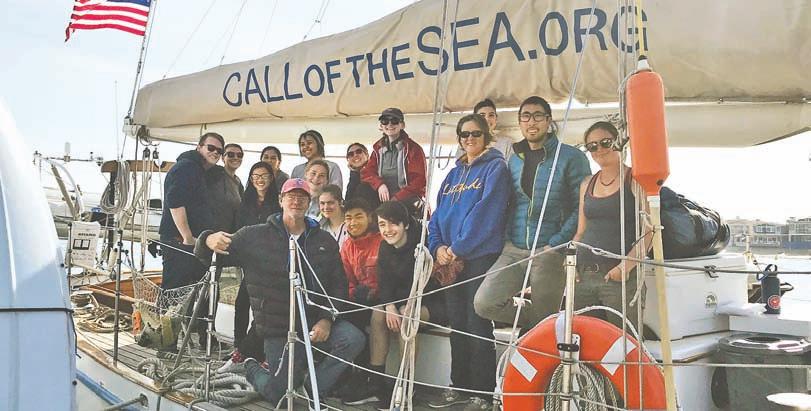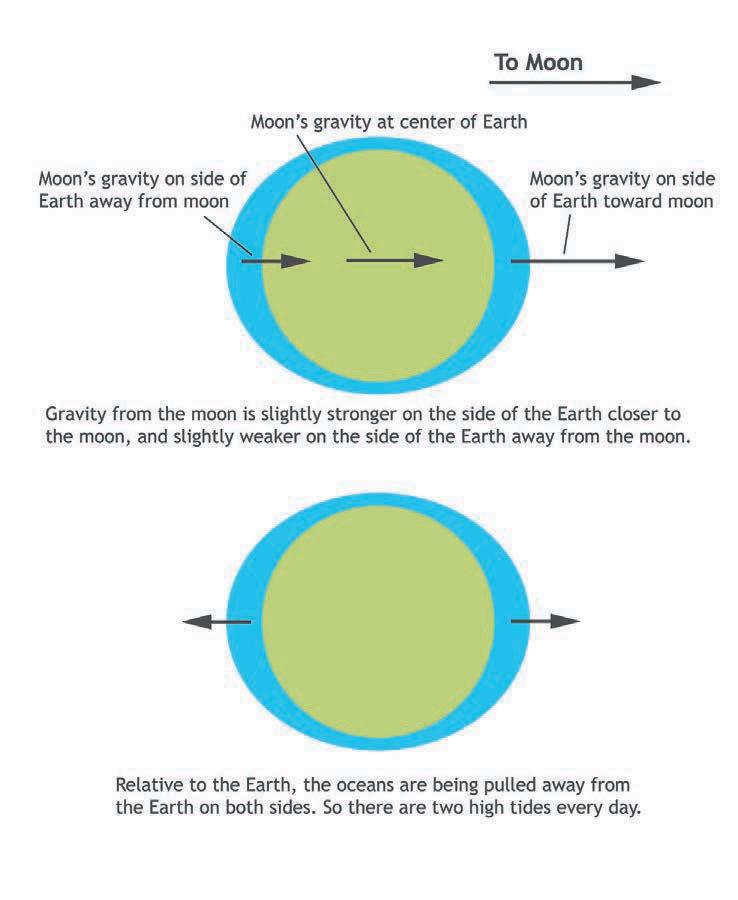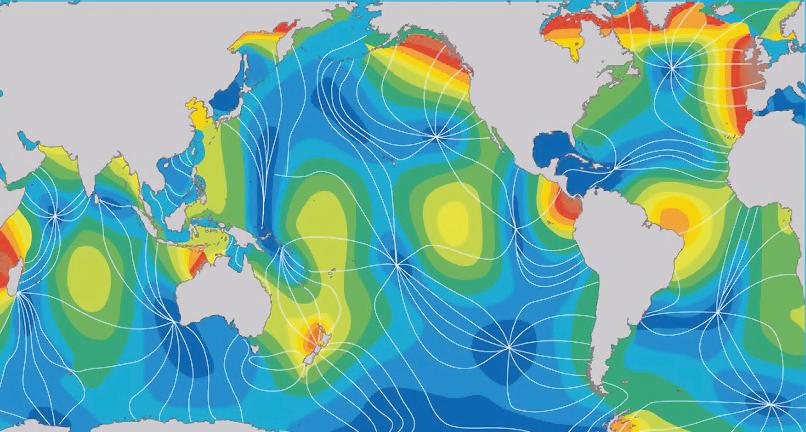
14 minute read
sea scouts on 'seaward
The Sea Scouts were all smiles as they arrived in Newport at the end of their week-long voyage.
to be less demanding than small-boat sailing. "There's bigger waves, definitely, but I feel like it's a little bit less stressful. On our boats, which are smaller, everyone has to be doing something. But here you can relax a bit more. There's still stuff to do, but, like, it's a lot fancier so you don't have to be holding stuff the whole time." Though her parents are not habitual sailors, Holiday was introduced to small-boat sailing at summer camps during her elementary school holidays. "My grandfather sailed a bit. And my father," she explained. "One year, my parents made me go to this other camp, which was in the City. I didn't like it as much, but it was at the Scouts' base. So I found out about Sea Scouts. We sailed to Angel Island, and that was a lot of fun. I ended up joining Sea Scouts when I was old enough. And I brought Amalie with me."
Advertisement
Holiday also recognized the differences in sizes and weights between her usual vessel, Viking, and Seaward. "Things are a lot heavier," she said.
Raising the anchor provided the perfect example. As Ben continued to work his side of the windlass, 14-year-old Amalie Letoile-Goga took the other. She too was equal to the task and between them the young sailors raised the ship's 50-lb anchor and gave the thumbs up to the captain, who powered up and headed back out to sea. "I really enjoyed this trip," Amalie said later. Like her fellow Scouts, Amalie had discovered some of the vast differences between sailing aboard the 30-ft-long Viking and 82-ft-long Seaward. "Everything is on a much bigger scale, so it's not like our boat, where you safely jibe it in a certain way," she added. "I think it was really important and interesting to relearn the basic skills that we need for sailing, on a bigger boat. I also really enjoyed sailing at night and seeing all of the stars and learning to navigate using landmarks. "More than just that," Amalie paused, "to use stars and the sun and have a better sense for, like, how we use the world around us to help us sail."
Right from the start of the voyage, Amalie had presented a bubbly enthusiasm for sailing and for her fellow crew. While some of her young shipmates mulled over various lines when setting sails, Amalie would almost whisper her views. "I think it's this one." A silent nod from the mate confirmed Amalie's choice. "She has the knowledge, but she needs to say it louder," Jessica said. "She doesn't yet have confidence in herself," a feeling which was no doubt experienced by many of the youth on board. "I like using the helm here [aboard Seaward] because we usually use a tiller for steering," said 15-year-old Caselyn Choy, who also shared that making new friends had been a part of her week-long journey. "It's been kind of interesting getting to know all these 14-year-olds," she added. "It's opened up this trip." final hours and the Scouts and crew aboard Seaward were all on deck enjoying (or lamenting) the gentle breeze that was pushing the vessel from Catalina Island toward their destination at the Newport Sea Scout base. Over the past five days, everyone had experienced the helm, the sails, the 24-hour watches and nights at anchor. And over the last two days, the Scouts had learned a little about the ship's engine and taken lessons in navigation. Nineteen-year-old Celeste McManus had taken a break from storytelling and was at the helm putting her navigation lessons into practice by executing a beat, a run, a tack and a jibe. As part of her Scouts' Quartermaster Award, Celeste needed to be in command of the vessel as she completed the maneuvers. "Piloting, like on a test, never made sense to me. At a regatta we would do it on a paper chart, in a room. When it's all theoretical I don't understand it all. But when it's like, 'Here's our boat, there's that rock, what's our compass course?' I'm like, 'Oh, now it makes sense.'" "When are we going to get the first maneuver out of the way?" someone asked. "You can go anytime," replied Capt. Jay. Celeste was still learning that large boats work at a different pace than the small boats she was accustomed to. By way of an example: Where on the Scouts' small boats the crew can just "reach over and get the sheet," on Seaward, "you've got to actually get there and get the sheet ready." "I feel like you do things slower than
we do, just for safety. Like everything takes a little bit more preparation on a big boat." "It's interesting," Celeste added. "Every time I do a maneuver, I know how to do things, but I'm pausing for a second because I think, 'Am I doing it the Sea Scout way, or am I doing it their way?'"
Despite the nuances of technique, the Scouts were all in agreement that sailing is essentially sailing, regardless of the vessel, and could fi nd many aspects of Seaward's handling that related to their own experience. "That's the nice thing about sailing," Celeste concluded, "it translates well between boats. It's a really cool skill." As the boat lolled in the lessening breeze, the only sound to be heard was the rhythmic creaking of the boom as it rocked gently with the swell. "Oh my God, that too!" added Celeste while turning to port. "With big boats everything's so loud."
It would be hard to pinpoint exactly which of the week's worth of new experiences made the biggest and most lasting impressions on the young sailors. But no doubt all will remember the beauty of sailing under a night sky ablaze with stars, watching the waves of bioluminescence slide past the hull, the grace of seabirds fl ying against the blue sky, and the pure joy radiating from the dolphins surfi ng beneath the bow.
Back at the Sea Scouts' base in San Francisco, the organization's leaders are pleased with the changes they can see in the voyaging Scouts' sailing performance. "There's defi nitely a better sense of how certain things we've learned about, but don't get a ton of hands-on practice doing, work," said organizer Tamara Sokolov. "Such as anchoring and charting; my crew members who've sailed to L.A. now say they have a better understanding of these. Since the majority of our sails are short day trips, there are things they've learned that have been somewhat abstract until now." A number of the seafaring Scouts have been inspired to join another ocean voyage, while others are happy to have had the experience. Regardless of their future preferences, they will all continue to learn and practice sailing as they participate in their usual vessels and programs on the Bay. In the meantime the organization is working to expand its membership and invite more and even younger sailors to experience sailing and learn about the SF Sea Scouts' programs. "We have a big open house once or twice a year that gets the word out," Tamara explained. "We offer free short sail rides, rowing, kayaking, a BBQ, and more. People can learn about it at our event page [www.seascout.family/ openhouse]. "Also, last year we started a program for middle schoolers called 'Maritime Explorers' that functions kind of like a Junior Sea Scout Program — we expose them to all the options Sea Scouts has to offer — sailing, rowing, power boating — through short day trips and activities so that by the time they've reached high school they know which Sea Scout program will be a fi t for them, and they've already learned the basics."
Perhaps these young Maritime Explorers will fi nd their passion and one day also experience the beauty of sailing the ocean aboard the schooner Seaward. — monica grant
SPAULDING BOATWORKS
Quality Workmanship for Over 60 Years
FULL SERVICE BOAT YARD Now a Spectra Watermakers Dealer Schedule a Consult Today!
Upcoming EventsWooden Boat
March 9th Dream Team: Movie Night! Holden Crane, Mutiny on the Bounty (1935) Anton Hottner,
Limited to 100 seats& Daniel Mollet
Doors open at 6:00PM

600 GATE 5 ROAD, SAUSALITO CA 1-415-332-3721

There's never any doubt when the keel of a boat under sail finds the mud. The boat fetches up with a soft but quick full stop, and the sense of motion changes from a living sailing machine to a dead, fixed object. It happens to everyone, and I don't really like to admit how often it's happened to me. No problem on a rising tide. But the last time I ran aground it was two hours before a very low tide that was falling fast. I should have known better. This was a "super moon" weekend: the high tides higher than the usual high, low tides lower than the usual low. The shortcut I was taking into the harbor is normally not a problem for my draft. Not this time.
We tried all the normal procedures: Heel way over, pump the sails, scull with the rudder. I even had two of my guests climb out on the boom for more heel. No luck. I was about to admit defeat and start the engine for some extra thrust when a kayak came into view from around the breakwater.
It was the last person I wanted to meet in this situation: Lee Helm, naval architecture grad student and sometimes my race crew, when she's not invited onto a faster boat. "Bottom too close to the top?" she taunted. "Beautiful sunset," I replied, gesturing to the west. "We thought we'd stop here to enjoy it." "You'll be stuck here for, like, forever," Lee informed us after taking a quick look at the tide app on her phone. "Tide's going down for another two hours. I'll take your anchor out to deeper water. If you act fast you can winch yourself off." "Worth a try," I said. "My guests have opera tickets tonight." I jumped down the main hatch to get the big anchor, stowed in an underberth locker to keep the weight low in the middle of the boat. "Are we going to have to wait till tomorrow morning for high tide?" I overheard one of my guests, a novice sailor, ask Lee while I was sorting out the not-quite-perfectly-coiled anchor line. "It was really high this morning when we left. Will it be as high again same time tomorrow morning?" "No way," Lee answered. "There are, like, two high tides and two low tides every day." "But if the high tide is caused by the gravitational attraction of the moon," my guest asked, "shouldn't that make the tide high when the moon is overhead, and low when the moon is on the other side of the Earth?" "You're not the first person to be confused by that," Lee responded, trying to be helpful. "Like, it's not the moon's gravity per se. It's the gravity gradient that causes tides." I could sense a confused pause, even with my head down in the anchor locker. "Think of it this way," said Lee. "If there were a constant gravity attraction from the moon, the Earth and all the water around it would be pulled by exactly the same gravitational acceleration, and there would be no tides at all." "But then how come . . ." "Thing is," said Lee, knowing exactly what the next question was going to be, "the moon's attraction is not the same everywhere. It gets less with distance, in fact by the inverse square root of distance. If you're, like, twice as far from the moon, the gravitational effect is only one quarter." "OK, but that doesn't explain . . ." "Actually it does," said Lee. "Let's use some round numbers. The moon is, on average, something like 250,000 miles away. The diameter of the Earth is about 8,000 miles, the radius is 4,000 miles. That puts the near side of the Earth at 246,000 miles from the moon, and the far side 254,000 miles from the moon. The force on the near side will be stronger by the ratio of the squares of the distance." Lee clearly must have been doing a quick calculation on her phone during a brief pause.



Global tidal response. The amphidromic points are the centers of the "swish," where there is essentially no tidal rise or fall. The radiating lines are cotidal lines, where tidal phases are similar. Shading represents tide amplitude.
"Two-hundred-fifty-four squared over 246 squared is 1.066. That means that there's 6.6% more lunar gravity on the side of the Earth facing the moon than on the side facing away from the moon. "So the Earth is being stretched?" "You got it! The Earth isn't stretchy, but the water can move around. The moon's gravity field tries to stretch the Earth along the Earth-moon axis. The water on the side of the Earth facing the moon is pulled away from the Earth. On the other side, the Earth is pulled away from the water. We get a high-tide bulge on both sides. Or we would if there were no continents and a uniform ocean. Reality, like, complicates things. The water in the various oceanic basins gets pulled around in a kind of swishing circular pattern, like wine in a glass being swished by the sommelier. And the cool thing is, there's a point in the middle of the swish where the tide doesn't go up or down at all: the amphidromic point. Boats sometimes sail right over it on the way to Hawaii. It's at about 27-35 north by 138 west." "And we feel the bump!" I shouted up from the cabin. "Why do we get stronger tides on the full moon or new moon?" asked another guest. "The influence of the moon should be the same for any phase of the moon, right?" "Do the same calculation for the sun," Lee suggested. "Ninety-three million miles away, so 93,004,000 on the sunny side of the Earth, 92,996,000 on the dark side. That's only a 0.017% difference, comparing the squares." "So then why does the sun have a significant effect on the tides?" I asked as I came back up on deck with the anchor and the newly organized and coiled anchor rode. "The sun weighs about 27 million times as much as the moon. But it's like 370 times as far, and you have to square that distance ratio to compare with moon gravity. We get . . . wait for it . . . about 3.3% difference in gravity on the sunny side of the Earth compared to the shady side. That means the sun has about half the tidal effect as the moon, on average." I lowered the anchor down into Lee's kayak, but my guests were still asking questions. "Shouldn't the sun's and moon's gravity partly cancel each other out when they're on opposite sides of the Earth?" one of them asked. "How come we get bigger tides on a full moon?" "Remember that it's the gradient, not the magnitude," Lee answered as she struggled to place the big anchor and chain in the kayak's tiny cockpit and still leave room for her legs. "The side with more gravity toward the moon is the same side with less pull toward the sun. The pull is opposite, but the gradient is the same sign, so it adds up." I don't think her last explanation dispelled any confusion, but Lee was in a hurry to get my anchor set in deep water, so without any further elaboration she set off paddling with my anchor toward the channel. As the rode paid out behind her I dashed below to get the spinnaker sheets, then used both of them to extend the rode by another four or five boatlengths. Lee lowered the anchor over the side when she had gone as far as the long rode would allow, and the chain rattled out after it. "Like, haul away!" she hailed. I wasn't completely ready — I still had to rig a block near the bow for a clean lead from the bow to a primary sheet winch. I took up slack, and by the time I started to crank on the big sheet winch, Lee was back alongside.
At first the boat just rotated toward the anchor. Then the load really







